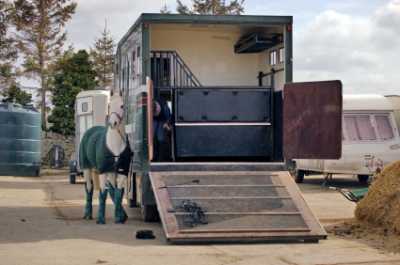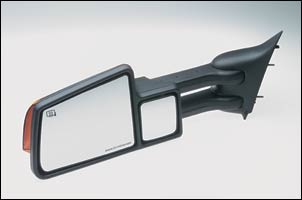|
By Jerry Tardif
Trailering draft or draft-size horses have some special considerations because the horses are bigger and they're heavier.
That affects all sorts of things from the speed you drive to clearances of which you need to be aware.
Hopefully, you've already got some towing experience under your belt.

There Are Various Large Trailers For Larger Horses
If so, pulling larger horses still requires the trailering knowledge and experience that you already have with additional considerations for the horse's larger size.
So, let's begin with the obvious:
- Assure your trailer is large enough for the draft horses.
That means high enough, long enough, and wide enough.
You also need to assure the trailer is rated for the weight of drafts.
If it is sized for them, it will very likely also be designed to take their added weight;
- Assure your vehicle is rated for the weight of the trailer you're going to use plus the weight of these large horses you're going to tow;
- Assure your vehicle's hitch is rated for the weight of this trailer plus the weight of these horses;
- If you're using a bigger tow vehicle, make sure you familiarize yourself thoroughly with this tow vehicle BEFORE the actual towing job.
Read its manual and drive it without a trailer to get used to its handling, turning, and stopping distances.
Make sure you know where all its controls are located;
- Pay particular attention to the brake controller and its adjustments, especially if it's not normally used with this trailer.
If it's an electric over hydraulic system, or any system different from that which you've used before, make sure you understand it, that it's working properly, and that you've gotten a feeling for its normal operation;
- If this is a larger/longer trailer than you usually tow, give yourself additional clearance around turns:
- If the trailer is wider, you may have to move your tow vehicle and ride a foot or more to the outside of the road than normally to assure you don't cross the center line;
- With a wider trailer, determine if you need temporary (or permanent) extended mirrors so you can see behind you when driving and for backing;

Extended Towing Mirrors Are Available For When Pulling Wide Trailers
- If the trailer is higher, be alert for bridge clearance heights and the same for road-crossing wires and branches.
This is another reason to drive slowly — you may find you need to stop before going under a low-hanging branch to avoid a crash;
- Drive a little more slowly once loaded.
Even if you're able to use your normal tow vehicle to pull these horses, you're going to notice the extra weight of these large horses and you need to adjust your driving accordingly.
That means driving more slowly and giving yourself more time and distance in which to slow down and stop at intersections; and
- Consider the ground conditions of your route and destination.
Hauling heavy loads in early spring can be a problem if the ground is saturated and soft.
Pulling a wider, taller, and/or heavier trailer requires some adjustments in your driving technique and additional alertness to assure you don't accidently strike anything with your extended dimensions.
You also need to be aware of slower acceleration and deceleration — that means longer starting and stopping distances must be accommodated.
You may want to plan your route to reduce the chances of problems from potential obstructions, sharp turns, and steep hills.
For example, it can be very difficult or even impossible to negotiate narrow roads or sharp turns with longer trucks and trailers — think of your total load length — think ahead.
Besides being an avid trail rider, Jerry Tardif is a technology consultant and a horse and nature photographer in SE Connecticut — see his work at: www.jerrytardif.com.
He is also co-founder and President of QueryHorse.
Back to Article Index
|